Zhenbo Luo
HyperClick: Advancing Reliable GUI Grounding via Uncertainty Calibration
Oct 31, 2025Abstract:Autonomous Graphical User Interface (GUI) agents rely on accurate GUI grounding, which maps language instructions to on-screen coordinates, to execute user commands. However, current models, whether trained via supervised fine-tuning (SFT) or reinforcement fine-tuning (RFT), lack self-awareness of their capability boundaries, leading to overconfidence and unreliable predictions. We first systematically evaluate probabilistic and verbalized confidence in general and GUI-specific models, revealing a misalignment between confidence and actual accuracy, which is particularly critical in dynamic GUI automation tasks, where single errors can cause task failure. To address this, we propose HyperClick, a novel framework that enhances reliable GUI grounding through uncertainty calibration. HyperClick introduces a dual reward mechanism, combining a binary reward for correct actions with a truncated Gaussian-based spatial confidence modeling, calibrated using the Brier score. This approach jointly optimizes grounding accuracy and confidence reliability, fostering introspective self-criticism. Extensive experiments on seven challenge benchmarks show that HyperClick achieves state-of-the-art performance while providing well-calibrated confidence. By enabling explicit confidence calibration and introspective self-criticism, HyperClick reduces overconfidence and supports more reliable GUI automation.
BTL-UI: Blink-Think-Link Reasoning Model for GUI Agent
Sep 19, 2025Abstract:In the field of AI-driven human-GUI interaction automation, while rapid advances in multimodal large language models and reinforcement fine-tuning techniques have yielded remarkable progress, a fundamental challenge persists: their interaction logic significantly deviates from natural human-GUI communication patterns. To fill this gap, we propose "Blink-Think-Link" (BTL), a brain-inspired framework for human-GUI interaction that mimics the human cognitive process between users and graphical interfaces. The system decomposes interactions into three biologically plausible phases: (1) Blink - rapid detection and attention to relevant screen areas, analogous to saccadic eye movements; (2) Think - higher-level reasoning and decision-making, mirroring cognitive planning; and (3) Link - generation of executable commands for precise motor control, emulating human action selection mechanisms. Additionally, we introduce two key technical innovations for the BTL framework: (1) Blink Data Generation - an automated annotation pipeline specifically optimized for blink data, and (2) BTL Reward -- the first rule-based reward mechanism that enables reinforcement learning driven by both process and outcome. Building upon this framework, we develop a GUI agent model named BTL-UI, which demonstrates consistent state-of-the-art performance across both static GUI understanding and dynamic interaction tasks in comprehensive benchmarks. These results provide conclusive empirical validation of the framework's efficacy in developing advanced GUI Agents.
Thinking in cocktail party: Chain-of-Thought and reinforcement learning for target speaker automatic speech recognition
Sep 19, 2025Abstract:Target Speaker Automatic Speech Recognition (TS-ASR) aims to transcribe the speech of a specified target speaker from multi-speaker mixtures in cocktail party scenarios. Recent advancement of Large Audio-Language Models (LALMs) has already brought some new insights to TS-ASR. However, significant room for optimization remains for the TS-ASR task within the LALMs architecture. While Chain of Thoughts (CoT) and Reinforcement Learning (RL) have proven effective in certain speech tasks, TS-ASR, which requires the model to deeply comprehend speech signals, differentiate various speakers, and handle overlapping utterances is particularly well-suited to a reasoning-guided approach. Therefore, we propose a novel framework that incorporates CoT and RL training into TS-ASR for performance improvement. A novel CoT dataset of TS-ASR is constructed, and the TS-ASR model is first trained on regular data and then fine-tuned on CoT data. Finally, the model is further trained with RL using selected data to enhance generalized reasoning capabilities. Experiment results demonstrate a significant improvement of TS-ASR performance with CoT and RL training, establishing a state-of-the-art performance compared with previous works of TS-ASR on comparable datasets.
Lightweight speech enhancement guided target speech extraction in noisy multi-speaker scenarios
Aug 27, 2025Abstract:Target speech extraction (TSE) has achieved strong performance in relatively simple conditions such as one-speaker-plus-noise and two-speaker mixtures, but its performance remains unsatisfactory in noisy multi-speaker scenarios. To address this issue, we introduce a lightweight speech enhancement model, GTCRN, to better guide TSE in noisy environments. Building on our competitive previous speaker embedding/encoder-free framework SEF-PNet, we propose two extensions: LGTSE and D-LGTSE. LGTSE incorporates noise-agnostic enrollment guidance by denoising the input noisy speech before context interaction with enrollment speech, thereby reducing noise interference. D-LGTSE further improves system robustness against speech distortion by leveraging denoised speech as an additional noisy input during training, expanding the dynamic range of noisy conditions and enabling the model to directly learn from distorted signals. Furthermore, we propose a two-stage training strategy, first with GTCRN enhancement-guided pre-training and then joint fine-tuning, to fully exploit model potential.Experiments on the Libri2Mix dataset demonstrate significant improvements of 0.89 dB in SISDR, 0.16 in PESQ, and 1.97% in STOI, validating the effectiveness of our approach. Our code is publicly available at https://github.com/isHuangZiling/D-LGTSE.
Shuffle-R1: Efficient RL framework for Multimodal Large Language Models via Data-centric Dynamic Shuffle
Aug 07, 2025Abstract:Reinforcement learning (RL) has emerged as an effective post-training paradigm for enhancing the reasoning capabilities of multimodal large language model (MLLM). However, current RL pipelines often suffer from training inefficiencies caused by two underexplored issues: Advantage Collapsing, where most advantages in a batch concentrate near zero, and Rollout Silencing, where the proportion of rollouts contributing non-zero gradients diminishes over time. These issues lead to suboptimal gradient updates and hinder long-term learning efficiency. To address these issues, we propose Shuffle-R1, a simple yet principled framework that improves RL fine-tuning efficiency by dynamically restructuring trajectory sampling and batch composition. It introduces (1) Pairwise Trajectory Sampling, which selects high-contrast trajectories with large advantages to improve gradient signal quality, and (2) Advantage-based Trajectory Shuffle, which increases exposure of valuable rollouts through informed batch reshuffling. Experiments across multiple reasoning benchmarks show that our framework consistently outperforms strong RL baselines with minimal overhead. These results highlight the importance of data-centric adaptations for more efficient RL training in MLLM.
Think Silently, Think Fast: Dynamic Latent Compression of LLM Reasoning Chains
May 22, 2025



Abstract:Large Language Models (LLMs) achieve superior performance through Chain-of-Thought (CoT) reasoning, but these token-level reasoning chains are computationally expensive and inefficient. In this paper, we introduce Compressed Latent Reasoning (CoLaR), a novel framework that dynamically compresses reasoning processes in latent space through a two-stage training approach. First, during supervised fine-tuning, CoLaR extends beyond next-token prediction by incorporating an auxiliary next compressed embedding prediction objective. This process merges embeddings of consecutive tokens using a compression factor randomly sampled from a predefined range, and trains a specialized latent head to predict distributions of subsequent compressed embeddings. Second, we enhance CoLaR through reinforcement learning (RL) that leverages the latent head's non-deterministic nature to explore diverse reasoning paths and exploit more compact ones. This approach enables CoLaR to: i) perform reasoning at a dense latent level (i.e., silently), substantially reducing reasoning chain length, and ii) dynamically adjust reasoning speed at inference time by simply prompting the desired compression factor. Extensive experiments across four mathematical reasoning datasets demonstrate that CoLaR achieves 14.1% higher accuracy than latent-based baseline methods at comparable compression ratios, and reduces reasoning chain length by 53.3% with only 4.8% performance degradation compared to explicit CoT method. Moreover, when applied to more challenging mathematical reasoning tasks, our RL-enhanced CoLaR demonstrates performance gains of up to 5.4% while dramatically reducing latent reasoning chain length by 82.8%. The code and models will be released upon acceptance.
VOC-ReID: Vehicle Re-identification based on Vehicle-Orientation-Camera
May 15, 2020
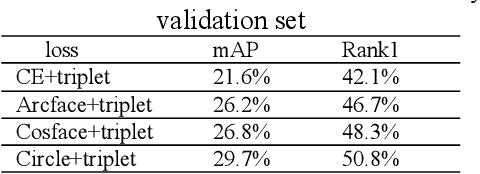
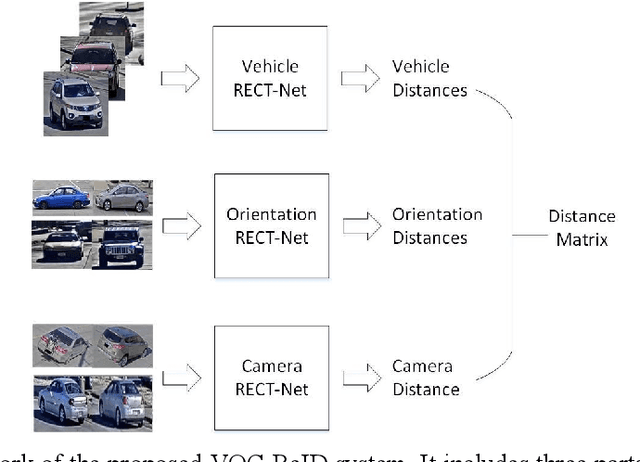

Abstract:Vehicle re-identification is a challenging task due to high intra-class variances and small inter-class variances. In this work, we focus on the failure cases caused by similar background and shape. They pose serve bias on similarity, making it easier to neglect fine-grained information. To reduce the bias, we propose an approach named VOC-ReID, taking the triplet vehicle-orientation-camera as a whole and reforming background/shape similarity as camera/orientation re-identification. At first, we train models for vehicle, orientation and camera re-identification respectively. Then we use orientation and camera similarity as penalty to get final similarity. Besides, we propose a high performance baseline boosted by bag of tricks and weakly supervised data augmentation. Our algorithm achieves the second place in vehicle re-identification at the NVIDIA AI City Challenge 2020.
Arbitrary Shape Scene Text Detection with Adaptive Text Region Representation
May 15, 2019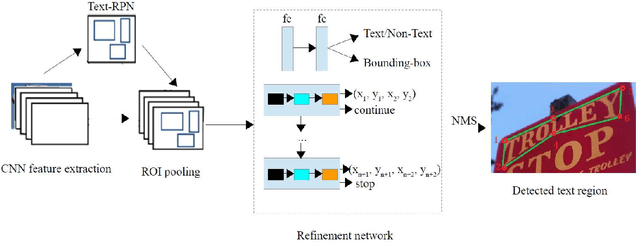
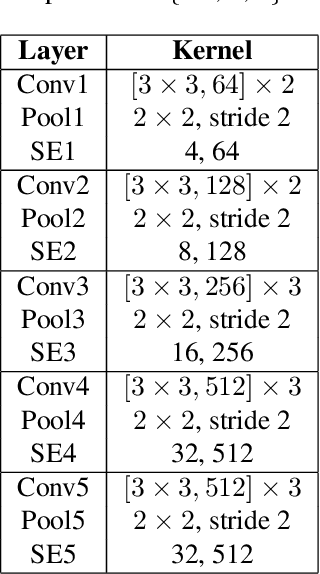
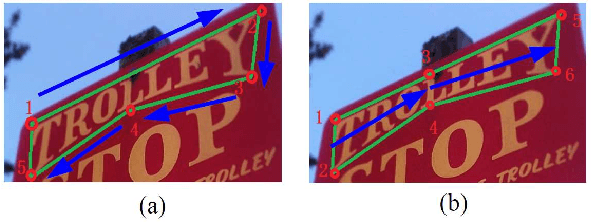
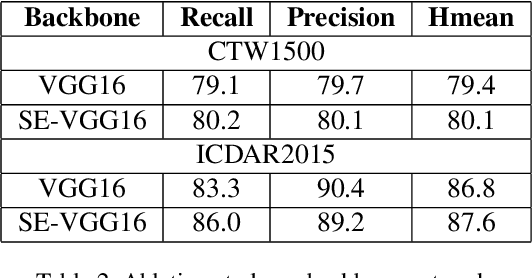
Abstract:Scene text detection attracts much attention in computer vision, because it can be widely used in many applications such as real-time text translation, automatic information entry, blind person assistance, robot sensing and so on. Though many methods have been proposed for horizontal and oriented texts, detecting irregular shape texts such as curved texts is still a challenging problem. To solve the problem, we propose a robust scene text detection method with adaptive text region representation. Given an input image, a text region proposal network is first used for extracting text proposals. Then, these proposals are verified and refined with a refinement network. Here, recurrent neural network based adaptive text region representation is proposed for text region refinement, where a pair of boundary points are predicted each time step until no new points are found. In this way, text regions of arbitrary shapes are detected and represented with adaptive number of boundary points. This gives more accurate description of text regions. Experimental results on five benchmarks, namely, CTW1500, TotalText, ICDAR2013, ICDAR2015 and MSRATD500, show that the proposed method achieves state-of-the-art in scene text detection.
Structured Knowledge Distillation for Semantic Segmentation
Mar 12, 2019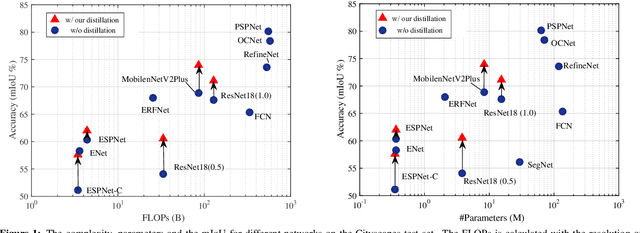
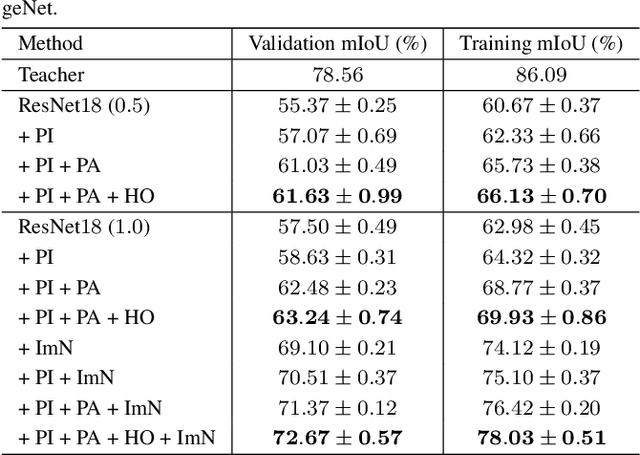
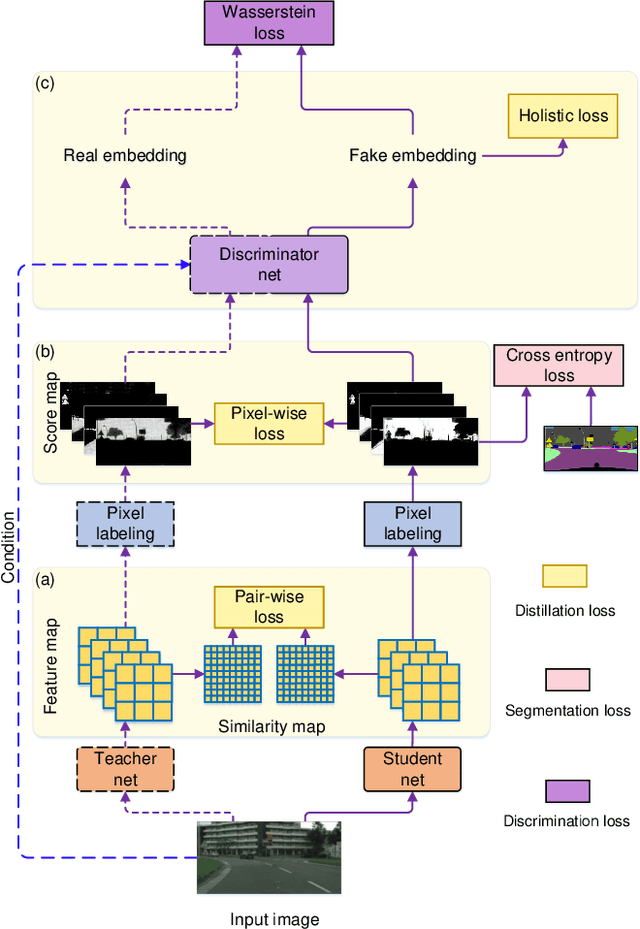
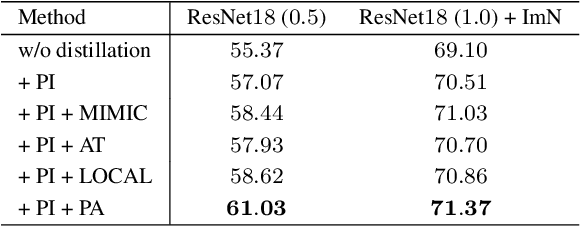
Abstract:In this paper, we investigate the knowledge distillation strategy for training small semantic segmentation networks by making use of large networks. We start from the straightforward scheme, pixel-wise distillation, which applies the distillation scheme adopted for image classification and performs knowledge distillation for each pixel separately. We further propose to distill the structured knowledge from large networks to small networks, which is motivated by that semantic segmentation is a structured prediction problem. We study two structured distillation schemes: (i) pair-wise distillation that distills the pairwise similarities, and (ii) holistic distillation that uses GAN to distill holistic knowledge. The effectiveness of our knowledge distillation approaches is demonstrated by extensive experiments on three scene parsing datasets: Cityscapes, Camvid and ADE20K.
Deep Residual Text Detection Network for Scene Text
Nov 11, 2017

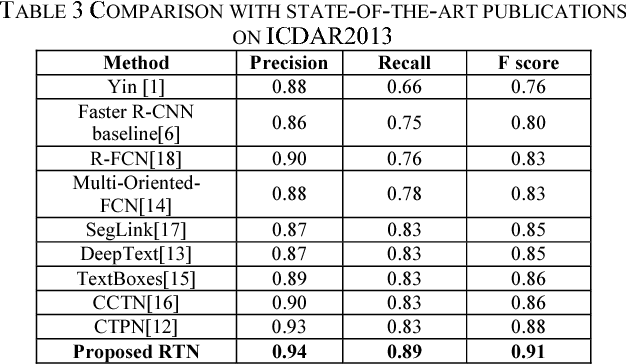
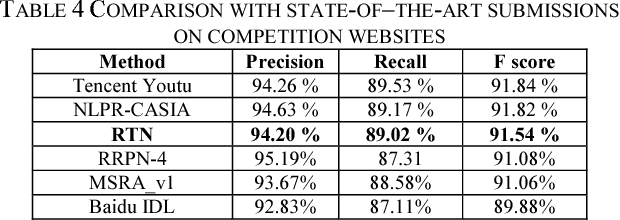
Abstract:Scene text detection is a challenging problem in computer vision. In this paper, we propose a novel text detection network based on prevalent object detection frameworks. In order to obtain stronger semantic feature, we adopt ResNet as feature extraction layers and exploit multi-level feature by combining hierarchical convolutional networks. A vertical proposal mechanism is utilized to avoid proposal classification, while regression layer remains working to improve localization accuracy. Our approach evaluated on ICDAR2013 dataset achieves F-measure of 0.91, which outperforms previous state-of-the-art results in scene text detection.
 Add to Chrome
Add to Chrome Add to Firefox
Add to Firefox Add to Edge
Add to Edge